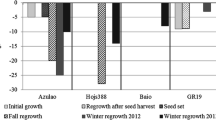Abstract
A triple-cross method is described as an alternative to the double-cross method for the production in kale of 100 per cent hybrid seed. This new method would reduce the labour involved and improve yields in the early stages of seed multiplication. These advantages would justify slightly lower yields of forage from triple-cross hybrids than from double-crosses.
Similar content being viewed by others
References
Richey, F. D., The convergent improvement of selfed lines of corn. Amer. Naturalist 61 (1927): 430–449.
Thompson, K. F., Breeding better kales. Agriculture 65 (1959): 487–491.
Thompson, K. F. and HowardH. W., Self-incompatibility in marrow-stem kale, Brassica oleracea var. acephala. II. Methods for the recognition in inbred lines of plants homozygous for S alleles. J. Genet. 56 (1959): 325–340.
Zeevaart, J. A. D., Heterosis in Brussels sprouts, especially with reference to cold resistance. Euphytica 4 (1955): 127–132.
Author information
Authors and Affiliations
Rights and permissions
About this article
Cite this article
Thompson, K.F. Triple-cross hybrid kale. Euphytica 13, 173–177 (1964). https://doi.org/10.1007/BF00033306
Received:
Issue Date:
DOI: https://doi.org/10.1007/BF00033306




